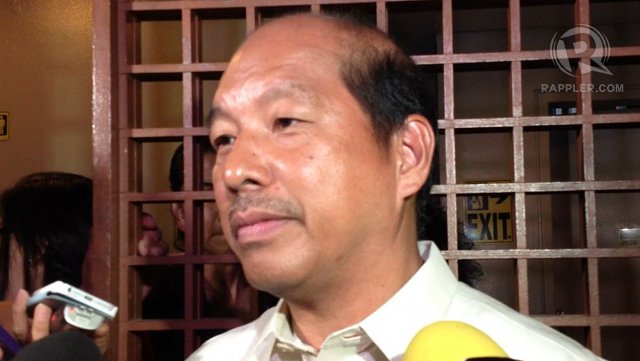SUMMARY
This is AI generated summarization, which may have errors. For context, always refer to the full article.

MANILA, Philippines – The Aquino Cabinet identified 5 immediate priorities in the aftermath of Super Typhoon Yolanda (Haiyan) costing the government P38.8 billion.
Budget Secretary Florencio Abad said that President Benigno Aquino III and his Cabinet discussed the immediate needs of the typhoon survivors in a meeting on Wednesday, November 27.
Abad told the Senate finance committee in a hearing on Thursday that the P38.8 billion will be needed for the following:
- Continuing relief
- Provision of shelter assistance (both building materials and temporary bunkhouses)
- Restoration of livelihood (cash for work program and early recovery program for fisheries and agriculture)
- Restoration of water and electricity services
- Rehabilitation of critical infrastructure (schools, health centers, hospitals, Tacloban airport terminal, key government buildings damaged)
The Senate finance committee approved the P14.6 billion supplemental budget for 2013, one of the sources of the needed P38.8 billion. The chamber also passed the joint resolution that will extend the validity of funds in the 2013 budget so that these can be used for calamity-related purposes until Dec 31, 2014.
Senate President Franklin Drilon is the author of the supplemental budget and the joint resolution. The House appropriations committee passed its version of the supplemental budget and the joint resolution on Wednesday.
Abad told reporters that the balance of the P38.8 billion will be sourced from the calamity fund, quick response funds (QRF), and unreleased appropriations for 2013.
The budget secretary said the team headed by the National Economic and Development Authority (NEDA) will finalize the plan Thursday and present again to the President on Friday.
“The bigger rehabilitation and reconstruction requirement will still have to be put together by NEDA because what we need to have are data to support the rehabilitation and reconstruction plan,” Abad said.
Other funds needed for reconstruction will come from the 2014 budget, which has an allocation of P100 billion for rehabilitation of disaster-hit areas.
Of the P100 billion, Abad said the P80 billion will come from loans from multilateral institutions and foreign governments.
“We expect that will be covered by concessional loans coming from the commitment from the Asian Development Bank which committed US$500 million and the World Bank which committed $900 million so a total of P66 billion. We also expect funds from JICA or EU,” he said referring to the Japan International Cooperation Agency and the European Union.
The world’s most powerful storm to make landfall, Yolanda devastated central Philippines and killed 5,560 as of November 28. The typhoon flattened entire towns and cities, and left 770,000 families homeless.
Lump sum budget?
During the hearing, Senate Finance Committee Chairman Francis Escudero asked Abad to give a breakdown of the P14.6 billion 2013 supplemental budget to reflect each department’s QRF allocation, and how much funds will be used to augment the President’s calamity fund.
Escudero said the Senate was avoiding putting lump sum allocations, which critics have opposed due to the lack of transparency. Abad agreed to provide the breakdown.
“We want it broken down into calamity fund and QRF of each agency because those have designations on where you can spend it and only in which areas,” Escudero said.
Escudero also had the supplemental budget amended to include transparency provisions found in the 2014 budget requiring the implementing agencies to report to Congress and the Commission on Audit, and to post documents on the use of the funds on their websites.
“I will make stronger representations with my counterpart for it to be adopted with the House,” Escudero said, referring to House Appropriations Chairman Committee Isidro Ungab.
The supplemental budget includes QRF allocations for two additional agencies: the Department of Health and the Department of Transportation and Communications.
Abad said, “We discovered due to Yolanda that we need to provide those two agencies with QRF. Because of amendments in the supplemental budget, they will be given [that].”
The Senate also agreed to amend its version of the supplemental budget so the funds can be used to help victims of other disasters. Initially, the bill was only meant for survivors of Yolanda, and typhoons Santi (Nari) and Labuyo (Utor), the magnitude-7.2 earthquake in the Visayas, and the Zamboanga siege.
The chamber agreed to include typhoons Pablo (Bopha), Vinta (Krosa), Sendong (Washi), and Odette (Usagi) to be consistent with the House version of the bill.
‘NDRRMC, DSWD must fix data’
In the hearing, Escudero and Drilon also criticized the National Disaster Risk Reduction and Management Council (NDRRMC) and the Department of Social Welfare and Development (DSWD) for presenting conflicting figures.
Escudero asked NDRRMC Executive Director Eduardo Del Rosario why his agency’s tally of the number of persons affected by Yolanda fluctuated from about 13 million last week to 9 million on Wednesday, and 10 million on Thursday.
Del Rosario said, “The classification of affected persons is based on factors like power services, water services. The important information here is the number of displaced persons.”
Escudero asked, “Hindi ko maintindihan bakit nagfu-fluctuate ang number of affected persons. So as of 6 am yesterday, may nabigyan ng power at tubig but as of 6 am today, nabawasan ang nabigyan natin ng power at tubig?”
(I don’t understand why the number of affected persons fluctuates. So as of 6 am yesterday, there were beneficiaries of power and water services, but as of 6 am today, the number of people who benefitted from them became less?)
Del Rosario said the NDRRMC just used reports the DSWD submitted.
Senators then asked Director Desiree Fajardo of the DSWD to explain the figures but she said she only had data as of November 20.
This prompted Drilon to say, “Now I can understand why the President loses his cool more often that not. Two agencies giving us different figures. I strongly suggest you have better coordination, at least on the data.” – Rappler.com
Add a comment
How does this make you feel?





There are no comments yet. Add your comment to start the conversation.